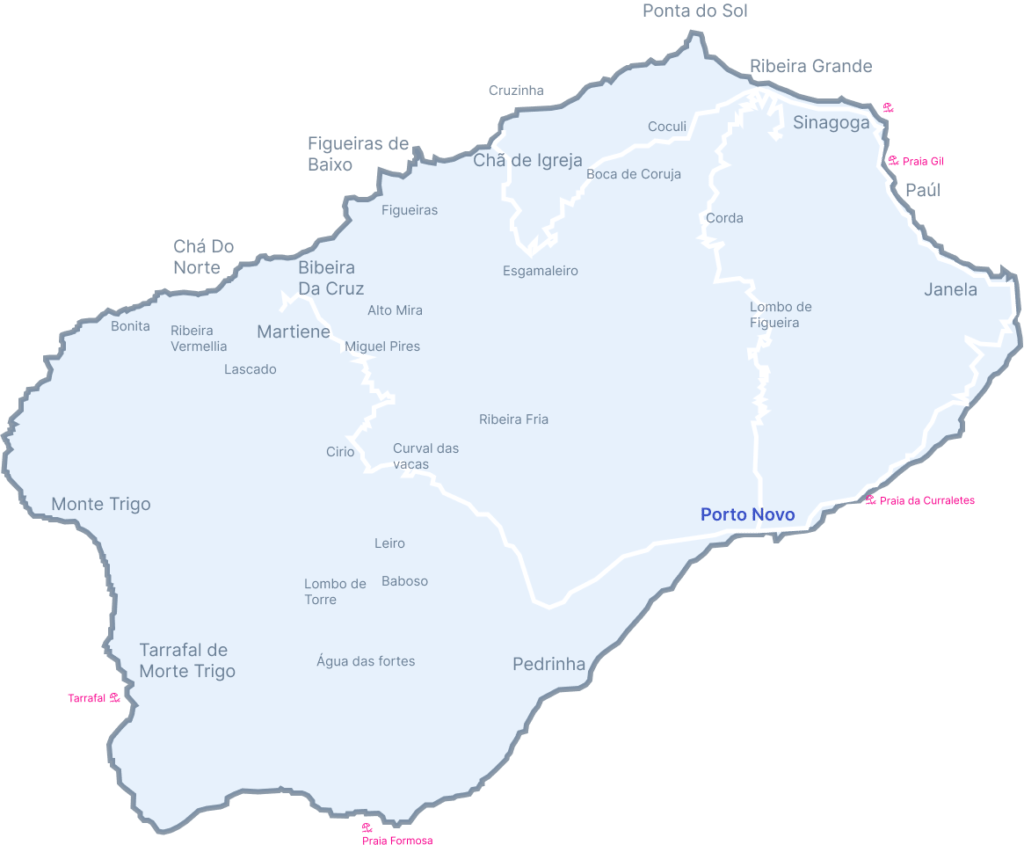The Island Santo Antão in Cabo Verde
The island of Santo Antão in Cabo Verde is the second largest, nearly 780 square kilometers, and the most mountainous island. With its high mountains, fertile green valleys, and romantic small villages, it is an ideal destination for nature lovers. You can take long walks or hikes or rent a car and follow the mountain route from Porto Novo to Riberia Granda. This is one of the most beautiful and scenic routes in Cabo Verde. And after a long day, you can relax on one of the deserted beaches with white or black volcanic sand.
Santo Antão also has the second-highest mountain in Cabo Verde, with a volcanic peak of almost 2,000 meters. The landscape is very diverse, ranging from parts with black lava moonscape to dense forests and fertile valleys with coconut, pineapple, and mango trees. Most people live in the towns of Porto Novo, Ribeira Granda, Paul, and Ponta do Sol. The south and west of Santo Antão are rather deserted.

The History of Santo Antão
After the discovery of Santo Antão on January 17, 1462, the island remained largely uninhabited for the first century. Maps of the 15th century show an imaginary line along the Atlantic Ocean that separated Spanish and Portuguese colonial rights. In the Treaty of Tordesillas of 1494, it was agreed that this north-south line would run 370 nautical miles west of Santo Antão. This divided the island between Portugal and Spain. The land west of the line belonged to Spain. All land to the east, including the other island of Cabo Verde and even Brazil, belonged to Portugal.
Today Santo Antão is a poor island with high unemployment. Opportunities for economic success are offered by tourism and agriculture
There are plans to turn the east of Porto Novo into a tourist area, centered on Escoralet beach (also known as Curraletes). It remains to be seen if any of the proposed developments will even take place in the near future. Santo Antão is one of the jewels of tourism in Cabo Verde and hopefully it can remain so without losing its authenticity.
The Weather in Santo Antão
Santo Antão how to get there?
The distance between Santo Antão and São Vicente is only 14 kilometers and it’s a one hour trip by ferry. The runway at Ponta do Sol has been closed for many years. It is simply too dangerous because of the strong crosswinds.
Take a ferry to Santo Antão
Most people traveling to Santo Antão take the ferry from Mindelo to Porto Novo. It’s a beautiful ride with an impressive view of São Vicente, the fearsome mountains behind Mindelo, and the harbor view. The port of Porto Novo has a brand new ferry terminal with a very rare novelty for Cabo Verde: escalators! Passengers can ride them up to the waiting platform. There is also an information desk that is only open when the ferries arrive and a lovely little café.
A single trip costs about $800. The ferries between Mindelo and Santo Antão are more reliable and on time than most other Cabo Verdean ships. As always, to be safe, we advise you to inquire beforehand. There is usually a ferry twice a day that you can take.
Tip: If you rent a car in Mindelo, some companies allow you to take your rental car between islands, just make sure before you plan to take a rental car on the ferry.
Take a yacht to Santo Antão
From December to May, the winds can be a hairy journey with gusts of up to 40 knots. This is because they are channelled by the two islands, creating a Venturi effect. To anchor in Porto Novo, the only port suitable for yachts, prior authorization from Mindelo is required
Tarrafal is also a possible anchorage, protected from the trade winds but with a constant swell that makes it difficult to land with a dinghy. Supplies would be basic (some food and water). Ponta do Sol is completely unsuitable for yachts.
Getting around in Santo Antão
Taxi
If you want to take the scenic inland mountain route, you must tell your driver, or he will take the new fast coastal road. It is definitely worth paying extra for this. It is unlikely that drivers in Santo Antão will charge too much. Many drivers base their trips from Porto Novo and Ribeira on the ferry schedules.
Renting a car
If you rent a car, remember that you want to go to the west of the island or visit Tarrafal, then only a 4×4 is suitable.
Festivals at Santo Antão
Like every island in Cabo Verde, Santo Antão has its own festivals every year. Locals and tourists come together to enjoy the festivities.
